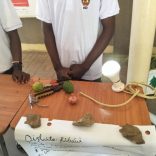Mozambique: 400 animals introduced into Banhine National Park
Watch: Moths in Mozambique tell ultrasound ‘fibs’ to avoid hungry bats: Study

What do you do if you’re a harmless little moth being hunted by a hungry bat? Tell him you taste bad, that’s what.
Research by a team led by US scientist Dr Jesse Barber in Gorongosa National Park in central Mozambique has shed more light on the fascinating ways in which moths use ultrasound to try to avoid becoming a bat’s next meal.
Watch Video below
In a trip last December that’s now the subject of an award-winning short documentary, Barber was able to test how moths in this stunning wild park emit ultrasound warning signals to send predatory bats a clear message: Don’t eat me. I’m poisonous.
Thing is, some moths are telling fibs.
In the film Barber and his research students are shown trapping moths and disabling their sound-producing organs. These moths are then offered to captured wild bats.
Even if they’re really hungry, the bats turn down the moths that are toxic. But the palatable moths that up to now have been successfully evading their predators by imitating the warning call of toxic moths?
These ones get eaten.
They are Batesian mimics, a term that’s not just reserved for moths but for any edible animal that has adapted by imitating another member of its group in its bid to stay alive.
Some butterflies do this visually, with harmless species flaunting a copy of the bright patterns of more honest toxic members of their species.
Barber’s PhD research first made him aware of the existence of the “acoustic mimicry rings” that moths use.
He told News24: “Now we are trying to figure out just how widespread they are.”
While he and his team have travelled to many parts of the world in their study of what Barber terms the “acoustic arms race” between bats and moths, this was their first trip to Africa.
Gorongosa was a particularly good place to study the phenomenon: there are more than 60 species of bat in this 4 000km squared park.
In Gorongosa, the team was able to find dozens of species of moths that mimic their poisonous relatives.
In fact, the trip was so successful that Barber is planning a repeat trip to Africa next March, this time to Gabon.
“We are documenting the path of evolution in one of the most diverse biological interactions on earth,” said Barber.
“Given the rate of extinction and human modification of the planet it is imperative that we uncover these patterns now! And do all we can to conserve this ancient battle in the night sky.”
The film “Moth Mimicry: Using Ultrasound to Avoid Bats” won the Best Short in the 2016 Science Media Awards in Boston. It was made by the Gorongosa Media Project and the Howard Hughes Medical Institute.












Leave a Reply
Be the First to Comment!
You must be logged in to post a comment.
You must be logged in to post a comment.